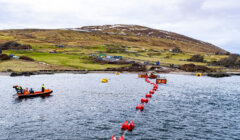Letters / Sharp practice
Thank you for your insightful article about the proposed Shetland electricity grid link. You raise serious issues, notably, relating to subsea cable failures.
I believe Boris Johnson has been in Orkney, on Thursday, fantasising: “With wind power, this area alone could produce 25 per cent of what’s needed for the whole of the UK.”
Really? Perhaps, he will consider the following, scandalous state of affairs:
At present, when the national grid has too much wind power, wind farms are “constrained off” (ordered to shut down). They receive payment for not generating which, remarkably, can exceed what they would earn from generating.
The total “constrained off” figure you quote (£123 million to end May) will be boosted in future by payments arising from vast wind farms not yet in operation.
The UK grid is already top-heavy with Scottish wind power due to the inadequacy of cross-border interconnectors. Much more is under construction, bringing fat slices of additional constraint charges to consumers’ bills. This is hidden from public scrutiny, behind a curtain of bureaucracy and obscure jargon.
When wind farms are generating they are paid for their output, at the price set in their contract which, on days of low wind, may amount to little or even, nothing at all. However, constrained off, they are guaranteed payment for their full load capacity, at a price which, incredibly, they are allowed to bid for themselves.
It gets worse. The figures you quote for average constraint payments (£73/MWh) are on top of the wholesale price of electricity (around £50/MWh), which they are also paid. Payments for being offline thus average around £120/MWh – 12p per unit, for electricity not generated! Consequently, they are likely to be paid substantially more for staying offline than if they were generating.
Become a member of Shetland News
Now, developers can enhance their profits by building behind grid “constraints” (unreliable or inadequate interconnectors) and placing high bids to be constrained off. The system incentivises it and while Ofgem is empowered to act, it rarely does so. Shetland, with a single, unburied subsea cable to the mainland grid would be a prime location for such sharp practice.
The problems you refer to with the Western Link are well-documented and under investigation by Ofgem. It is surely obvious that planned, multi-billion, subsea cable investments should be halted until the Western Link issues have been thoroughly understood and resolved.
Furthermore, the brand new (2017) Caithness-Moray subsea link, intended to carry renewable energy onwards from Caithness, has already required fault repairs. The Shetland-Caithness cable will pass through prolific, international fishing grounds (biggest cause of cable failures), in seas notorious for fierce storms, adding physical damage to its risk profile.
None of this inspires confidence. Failures can take weeks, even months, to repair and payments for not generating will be massive – around £55,000/hr for Viking Energy, alone, at the current average rate.
Renewable energy exports from Shetland will depend on these three cables, an ideal situation for maximising constraint income. SSE shareholders will benefit, while consumers pay eyewatering sums for nothing.
Renewable energy is not, as developers and governments like to portray, a job-creating ‘magic money tree’. Somebody has to pay for it. Long-suffering consumers, bludgeoned into submission by climate guilt cudgels, will foot the bill.
Is it any wonder fuel poverty is soaring?
John Tulloch
Arrochar
Become a member of Shetland News
Shetland News is asking its readers to consider paying for membership to get additional perks:
- Removal of third-party ads;
- Bookmark posts to read later;
- Exclusive curated weekly newsletter;
- Hide membership messages;
- Comments open for discussion.
If you appreciate what we do and feel strongly about impartial local journalism, then please become a member of Shetland News by either making a single payment, or setting up a monthly, quarterly or yearly subscription.














































































